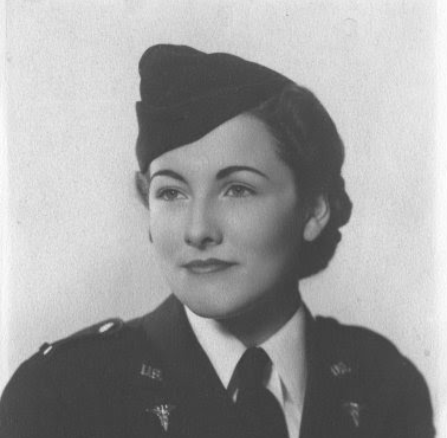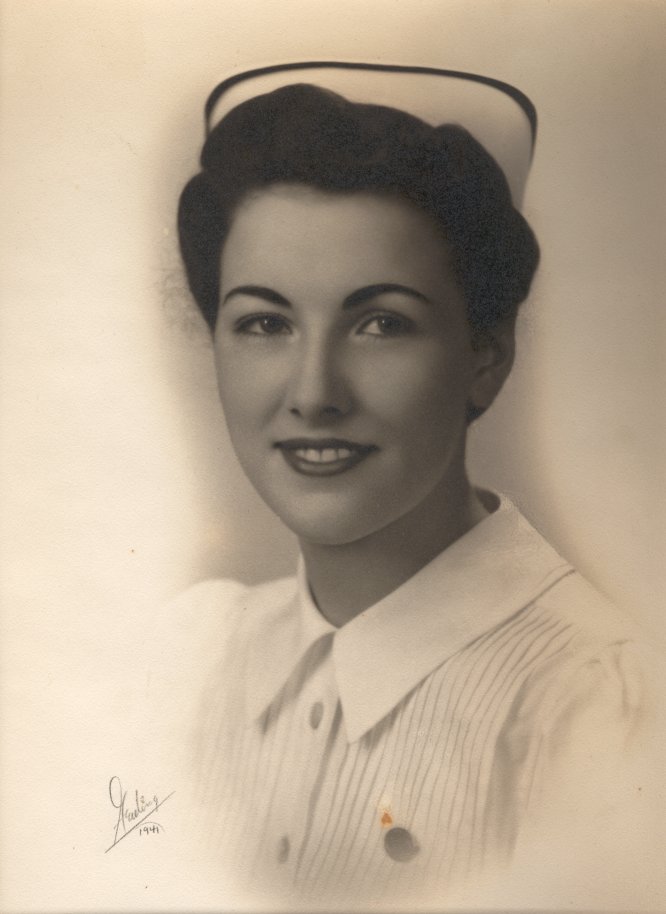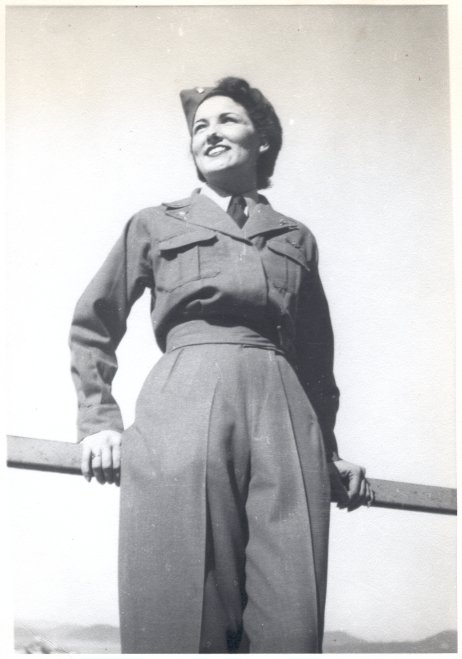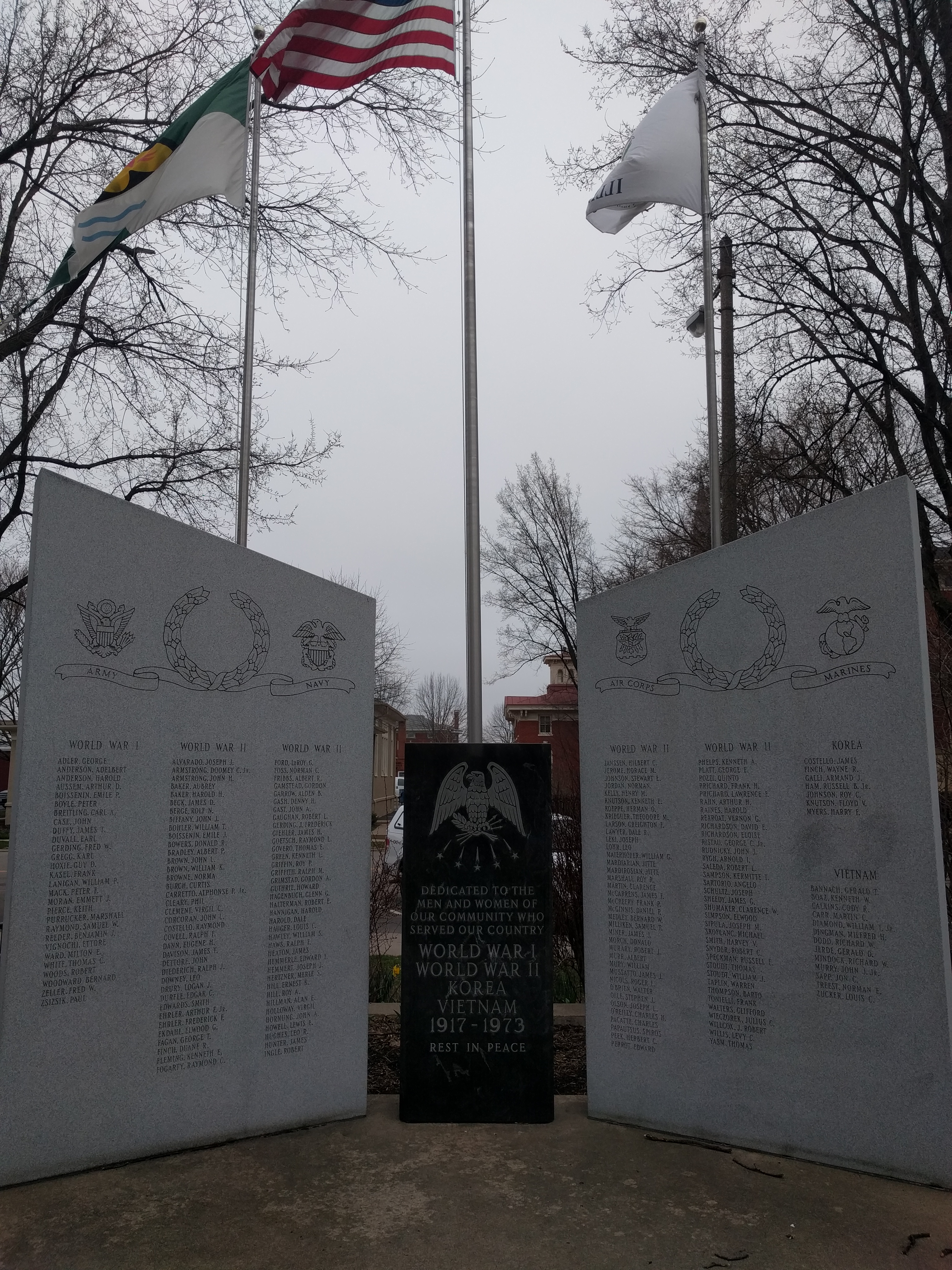Second Lieutenant Eloise Marie Richardson

- Unit: 801st Medical Air Evacuation Squadron
- Service Number: N-731623
- Date of Birth: April 18, 1920
- Entered the Military: October 15, 1942
- Date of Death: May 19, 1945
- Hometown: Marseilles, Illinois
- Place of Death: en route to Guadalcanal
- Award(s): Purple Heart
- Cemetery: Walls of the Missing. Manila American Cemetery, Manila, Philippines
Garnet Valley High School
2016-2017
Early Life
Born on April 18, 1920, Eloise Marie Richardson was the second eldest daughter of William Floyd and Cora (Corrigan) Richardson. William worked as a millwright and maintained the machinery at National Biscuit Company, and Cora stayed home to tend to their home and children. The family resided at 491 Lincoln Avenue in Marseilles, Illinois, in the 1940s.
Richardson had four siblings with whom she was close: one older, Mary Ellen, and three younger, Jim, Billy, and Eleanor. Eloise always treated Eleanor well, often taking her on excursions and buying her nice clothes. The sisters were 13 years apart and sometimes pretended they were mother and daughter when they were out and about town. Even as a teenager, Eloise liked to take care of people.
She was a gifted student who graduated from Marseilles High School in just three years. However, because she was just 17 years old, she had to wait until her birthday to meet the age requirement to enroll in nursing school.
Richardson trained as a nurse at Ryburn-King Hospital School in nearby Ottawa, Illinois. After matriculation, she joined the nursing staff at Ryburn-King. According to the Daily Republican Times, she was “one of the most popular nurses on staff.” Eloise later worked at Cook County Hospital in Chicago. According to family, she likely sought this professional opportunity in a big city with hopes of encountering more challenging, complex conditions while furthering her medical knowledge.

Military Experience
Training
Richardson became one of the first women in La Salle County to enlist in the service when she volunteered for the U.S. Army Nurse Corps on October 15, 1942. Richardson’s patriotism, desire to help others, and dreams of seeing the world likely motivated her enlistment. Her initial placement took her to Elkins, West Virginia. Richardson then transferred to the 27th Evacuation Hospital at Breckinridge, Kentucky, where she underwent flight training at Bowman Field. Second Lieutenant Richardson received her “golden wings,” which indicated her successful completion of the flight nurse program, when she graduated from Bowman Field on November 26, 1943.
The U.S. Army assigned Richardson to the 801st Medical Air Evacuation Squadron. She enjoyed a brief leave at home in November 1943. Her sister, Eleanor, recalled Eloise’s excitement during her trip back to Marseilles, as she eagerly anticipated her first overseas assignment. Richardson departed San Francisco on March 8, 1944 for her assigned post at Guadalcanal.
Service in the Pacific
The daily tasks of a flight nurse in the Pacific were both difficult and dangerous. Richardson had to be in top physical shape to provide care for her patients during taxing flight missions. She trained in crash protocol, evacuation procedures, and survival techniques. Nurses needed to understand how the high altitudes encountered on the evacuation flights might impact their patients and their care. They also had to be versed in not only treating war injuries, but also tropical diseases that soldiers might contract like beriberi and malaria.
Each nurse was required to have three items on her person at all times: a cross, in the hope that if the flight went down, natives would associate the cross with missionaries and therefore hopefully treat the woman well, a pistol for protection and hunting if circumstances turned dire, as well as a cigarette lighter for illumination, cooking, and signaling for help. Many women also carried the Protestant and Catholic version of the last rites to provide comfort to those who were critically wounded.
The C-47s used for medical evacuations were frequently used for multiple purposes and sometimes even carried military supplies on the rescue flights. This practice prevented the planes from being designated with a red cross, the common symbol to denote a medical vessel. The crew and patients aboard therefore faced the same risks as if the plane carried a combat crew.
For this reason, the U.S. Army only accepted volunteers to serve as flight nurses and medical technicians. The risks of her job weighed heavily upon Richardson’s mind; a fellow flight nurse with the 801st Medical Air Evacuation Squadron, Helena (Ilic) Tynan, recalled a conversation at a party during which Richardson confided in her that she did not think that she would make it off the island alive.
Her Last Mission
On May 18, 1944, Richardson served as a flight nurse on a U.S. Marine Corps C-47 on a routine flight between Bougainville, located in Papua New Guinea, and Guadalcanal, located in the Solomon Islands. It was customary for planes taking this path to fly southwest until a safe distance from the enemy was reached, then bank southeast towards the destination. Typically this meant the plane was always in sight of land and that it would pass over air bases on the Treasury and New Georgia Islands.
The pilot, First Lieutenant Richard Haralson, was experienced and familiar with this route, and the plane was in good operating condition, having just passed a 1,000 hour check a week prior. Minor adjustments had been made to the plane the night before the flight.
The C-47 carried 1,300 pounds of mail and 23 people, including injured soldiers. A crew of six U.S. Marines operated the plane. Richardson traveled as the flight nurse, and there were nine passengers from the U.S. Army, three from the U.S. Navy, one from the U.S. Marine Corps, and three U.S. Coast Guardsmen on board.
The plane took off at 10:08 a.m. from Torokina, on the west central coast of Bougainville, under “threatening weather conditions” and amidst rain showers that had reduced visibility from six miles to one mile. The plane made no contact after take off and never reached its destination.
When its absence was discovered, all stations were alerted, and, for two days, 32 C-47s, six B-25s, and two PBY amphibious aircraft made thorough search attempts, coupled with surface searches by PT boats. The Missing Air Crew Report stated that “every clue and all floating wreckage in the entire area were investigated but all efforts to locate the plane and crew members were unsuccessful.” The official documents offer no theory as to what might have gone wrong onboard the C-47 that night; there are no references to mechanical or pilot error or an unexpected encounter with an enemy.
Missed Connections
Nurse Helen Hunter had likely watched that C-47 take off from Bougainville with a twinge of envy. She and Richardson had sought to switch shifts to allow Hunter to make that particular flight to Guadalcanal to attend a dance with her boyfriend, bomber pilot Robert Weant. However, the paperwork did not process in time, meaning it was Richardson, rather than Hunter, on the doomed plane.
Hunter’s initial misfortune turned out to be lucky in the long-run. Both she and Weant survived the war and eventually married. Eloise’s chief nurse, Lucy (Wilson) Jopling, teared up over forty years later when remembering the circumstances of Richardson’s disappearance in 1944. As Richardson’s direct superior, Wilson was given the unenviable task of writing home to her parents to break the bad news about their daughter; she recalled that “those are the things that never leave you.”
In another cruel twist of fate, Eloise’s brother, Corporal Jim Richardson, was just minutes away from his sister in Bougainville on May 18, 1944. Jim, a paratrooper serving in the Pacific Theater with the Fifth Marines, was injured and receiving treatment in the hospital there. The siblings missed their chance for one final reunion; neither was aware the other was just steps away. Jim was later injured in the Battle of Iwo Jima. Meanwhile, a continent away, the Marseilles, Illinois, town physician had been tasked with hand-delivering ominous communications from the War Department to parents in Marseilles. He visited the Richardson household twice that year. Jim would come home, but Eloise would not.
A Painful Conclusion
Eloise’s family first received communication about their daughter’s plane accident in a telegram on May 26. Richardson was the first flight nurse in the South Pacific to be listed as Missing in Action (MIA). Eloise’s last letter to her parents, written May 10, had arrived in Marseilles just eight days before the grim news of her disappearance.
The Richardsons received an official update months later from the government informing them that there was still no information regarding their daughter’s whereabouts. Then, as months came and went, in accordance with Public Law 490, the War Department issued a presumptive finding of death.
Richardson’s date of death was recorded as May 19, 1945, the day after a 12-month period of absence, within which there was no evidence of her survival. Although this move allowed the military to create the closure it needed to process her death benefits, Eloise’s parents never quite attained such a sense of comfort and finality. They always held out hope that their little girl might one day return.
About 500 U.S. Army nurses served on 31 medical air evacuation squadrons globally during World War II. These women completed evacuations for nearly 1.2 million patients throughout the war and, incredibly, lost only 46 of the wounded en route when the planes reached their destinations. The astonishing success rate of these missions is a clear tribute to the grit and skill of these flight nurses. In addition to Richardson, 16 other flight nurses made the ultimate sacrifice during World War II.


Eulogy
Second Lieutenant Eloise M. Richardson is commemorated today on the Walls of the Missing at Manila American Cemetery. Her name is inscribed alongside 36,285 other Fallen Heroes, including the 22 other service members who died on that same doomed flight. Eloise is also remembered at the Women in Military Service for America Memorial at Arlington National Cemetery and in her hometown community in Marseilles, and Ottawa, Illinois, on their respective World War II memorials.

Reflection
Bibliography
At the AAF School of Air Evacuation at Bowman Field, Ky., student flight nurses learned how to handle patients with the aid of a mock-up fuselage of a Douglas C-47 transport. Photograph. U.S. Air Force. National Museum of the U.S. Air Force. Image. www.nationalmuseum.af.mil/Visit/MuseumExhibits/FactSheets/Display/tabid/509/Article/196161/winged-angels-usaaf-flight-nurses-in-wwii.aspx.
Barger, Judith. Beyond the Call of Duty: WWII Flight Nursing in World War II. Kent, OH: Kent State University Press, 2013.
Barger, Judith. “World War II Army Flight Nurses – 8 August 2015.” Judith Barger, Author: Putting a Unique Stamp on Women and History. Last modified August 8, 2015. Accessed March 26, 2017. judithbarger.com/world-war-ii-flight-nurses-8-august-2015/.
Deak, William J. “Eloise.” Historical Data, 1 May 1944 to 31 May 1944, 801 MAES, 2 June 1944. Air Force Historical Research Agency.
“Eloise M. Richardson.” American Battle Monuments Commission. Accessed March 23, 2017. www.abmc.gov/node/521894#.WN52_BLyvCQ.
“Eloise Richardson Now 2nd Lt. in Nursing Corps,” Daily Republican Times (Ottawa, IL), November 16, 1943.
Eloise Richardson, Official Military Pay Record, Department of the Army.
Foster, Kevin. Telephone interview with author. March 26, 2017.
Helena Ilic Tynan, interview with Judith Barger, April 26, 1986.
Illinois. La Salle County. 1930 U.S. Census. Digital Images. ancestry.com.
Illinois. La Salle County. 1940 U.S. Census. Digital Images. ancestry.com.
“Hope Still Held Out for Missing Lt. Richardson,” Daily Republican Times (Ottawa, IL), June 6, 1944.
“Lt. E. Richardson Receives Wings at Bowman Field, Kentucky,” Newspaper clipping. Collection of Kevin Foster.
“Lt. Richardson Missing Since 18th of May,” Marseilles Press, May 27, 1944.
“Lt. Richardson, Nurse, Declared Officially dead,” Newspaper clipping. Collection of Kevin Foster.
“Marseilles Army Nurse Listed as MIssing in Action,” Daily Republican Times (Ottawa, IL), May 26, 1944.
“Marseilles Girl Lost in Pacific.” Chicago Daily Times, May 31, 1944.
Missing Air Crew Report; Office of the Quartermaster General, Memorial Division, Identification Branch, 1942-1947, MACR 16545; National Archives at College Park, College Park, MD.
“Nurse Awarded Purple Heart Posthumously,” Daily Republican Times (Ottawa, IL), August 2, 1945.
Pearce, Eleanor Richardson. Telephone interview with author. March 29, 2017.
2nd Lt. Eloise Richardson of Marseilles, Illinois, and Lt. John F. Buehler of Claflin, Kansas, enjoy an evening at the officers’ club. Photograph. April 1944. National Archives and Records Administration (68537). Image.
Richardson Family Photographs (Assorted). 1940-1944. Courtesy of Kevin Foster and Family.
The 13th Air Force’s airwomen live a hazardous life and have earned the respect of the male fliers in the veteran air force. Photograph. 1944. National Archives and Records Administration (54361). Image.
“War Department Has No Further Word on Lt. Richardson.” Newspaper clipping. Collection of Kevin Foster.
War Memorial in Ottawa, Illinois. Photograph. 2017. Courtesy of Kevin Foster.
William Floyd Richardson. World War II Draft Registration Card. DIgital images. ancestry.com.
“Winged Angels: USAAF Flight Nurses in WWII.” National Museum of the U.S. Air Force. Last modified May, 1, 2015. Accessed March 26, 2017. www.nationalmuseum.af.mil/Visit/MuseumExhibits/FactSheets/Display/tabid/509/Article/196161/winged-angels-usaaf-flight-nurses-in-wwii.aspx.
This profile was researched and created with the Understanding Sacrifice program, sponsored by the American Battle Monuments Commission.

